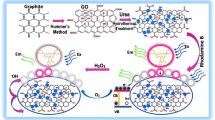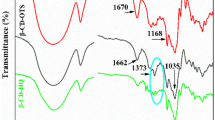Abstract
The authors describe a "turn-on" fluorometric method for determination of β-carotene. It is based on competitive host-guest interaction between rhodamine 6G (R6G) and β-carotene and graphene oxide nanoparticles that were functionalized with β-cyclodextrin (β-CD)-modified polyethylenimine (β-CD-PEI-GO). On addition of R6G to a solution of β-CD-PEI-GO, its fluorescence is quenched because of the inclusion of R6G into the β-CD moiety. Both Förster resonance energy transfer and electron transfer are likely to occur. On further addition of a sample containing β-carotene, it will replace R6G in the cavity, thereby releasing R6G to the bulk solution. This is due to the stronger affinity of β-carotene for β-CD in the complex, but also because of repulsion between the positively charged β-CD-PEI-GO complex and the positively charged R6G dye. The displacement of R6G by β-carotene leads to fluorescence recovery whose efficiency (expressed as F/F0) is related to the β-carotene concentration in the range from 0.1 to 4.0 μmol⋅L‾1. The detection limit for β-carotene is 5.4 nmol⋅L‾1 which is lower than that of any other optical method.

Graphene oxide hybrid materials can quench the fluorescence of rhodamine 6G by surface energy transfer. The addition of β-carotene to the solution results in the recovery of the fluorescence of the system owing to the release of rhodamine 6G from the graphene oxide hybrid materials.





Similar content being viewed by others
References
Brabcová I, Hlaváčková M, Šatínský D, Solich P (2013) A rapid HPLC column switching method for sample preparation and determination of β-carotene in food supplements. Food Chem 141:1433–1437
Li B, Harjani JR, Cormier NS, Madarati H, Atkinson J, Cosa G, Pratt DA (2013) Besting vitamin E: sidechain substitution is key to the reactivity of naphthyridinol antioxidants in lipid bilayers. J Am Chem Soc 135:1394–1405
Tapiero H, Townsend DM, Tew KD (2004) The role of carotenoids in the prevention of human pathologies. Biomed Pharmacother 58:100–110
Barba AIO, Hurtado MC, Mata MCS, Ruiz VF, Tejada MLSD (2006) Application of a UV–vis detection-HPLC method for a rapid determination of lycopene and β-carotene in vegetables. Food Chem 95:328–336
Biswas AK, Sahoo J, Chatli MK (2011) A simple UV-Vis spectrophotometric method for determination of β-carotene content in raw carrot, sweet potato and supplemented chicken meat nuggets. Food Sci Technol 44:1809–1813
Ziyatdinova G, Ziganshina E, Budnikov H (2012) Voltammetric determination of β-carotene in raw vegetables and berries in Triton X100 media. Talanta 99:1024–1029
Pilar V, María BB, Ignacio LG, Manuel HC (2013) Quantification of β-carotene, retinol, retinyl acetate and retinyl palmitate in enriched fruit juices using dispersive liquid–liquid microextraction coupled to liquid chromatography with fluorescence detection and atmospheric pressure chemical ionization-mass spectrometry. J Chromatogr A 1275:1–8
Nagarkar SS, Desai AV, Ghosh SK (2015) A nitro-functionalized metal–organic framework as a reaction-based fluorescence turn-on probe for rapid and selective H2S detection. Chem Eur J 21:9994–9997
Yang J, Moraillon A, Siriwardena A, Boukherroub R, Ozanam F, Gouget-Laemmel AC, Szunerits S (2015) Carbohydrate microarray for the detection of glycan–protein interactions using metal-enhanced fluorescence. Anal Chem 87:3721–3728
Cherry RJ, Chapman D, Langelaar J (1968) Fluorescence and phosphorescence of β-carotene. Trans Faraday Soc 64:2304–2307
Freeman R, Finder T, Bahshi LL, Willner I (2009) β-cyclodextrin-modified CdSe/ZnS quantum dots for sensing and chiroselective analysis. Nano Lett 9:2073–2076
He LL, Yang XH, Zhao F, Wang K, Wang Q, Liu JB, Huang J, Li WS, Yang M (2015) Self-assembled supramolecular nanoprobes for ratiometric fluorescence measurement of intracellular pH values. Anal Chem 87:2459–2465
Luo J, Zhang J, Lin J, Wang J, Yang P (2015) Enrichment and sensitive detection of polyphenolic compounds via β-cyclodextrin functionalized fluorescent gold nanorods. Microchim Acta 182:201–208
Wang M, Wu H, Chi Y, Chen G (2014) Synthesis of Au13(glutathionato)8@β-cyclodextrin nanoclusters and their use as a fluorescent probe for silver ions. Microchim Acta 181:1573–1580
Liu JS, Liu GN, Liu WX, Wang YR (2015) Turn-on fluorescence sensor for the detection of heparin based on rhodamine B-modified polyethyleneimine-graphene oxide complex. Biosens Bioelectron 64:300–305
Liu L, Xia N, Yu J (2015) A graphene oxide-based fluorescent scheme for the determination of the activity of the β-site amyloid precursor protein (BACE1) and its inhibitors. Microchim Acta. doi:10.1007/s00604-015-1647-9
Duan YF, Ning Y, Song Y, Deng L (2014) Fluorescent aptasensor for the determination of Salmonella typhimurium based on a graphene oxide platform. Microchim Acta 181:647–653
Mondal A, Jana NR (2012) Fluorescent detection of cholesterol using β-cyclodextrin functionalized graphene. Chem Commun 48:7316–7318
Li Y, Gao Y, Li YN, Liu SY, Zhang H, Su XG (2014) A novel fluorescence probing strategy based on mono-[6-(2-aminoethylamino)-6-deoxy]-β-cyclodextin functionalized graphene oxide for the detection of amantadine. Sensor Actuat B 202:323–329
Liu JS, Liu GN, Liu WX (2014) Preparation of water-soluble β-cyclodextrin/poly(acrylic acid)/graphene oxide nanocomposites as new adsorbents to remove cationic dyes from aqueous solutions. Chem Eng J 257:299–308
Sharma P, Das MR (2013) Removal of a cationic dye from aqueous solution using graphene oxide nanosheets: investigation of adsorption parameters. J Chem Eng Data 58:151–158
Song SJ, Ma YF, Shen H, Zhang MX, Zhang ZJ (2015) Removal and recycling of ppm levels of methylene blue from an aqueous solution with graphene oxide. RSC Adv 5:27922–27932
Samal SK, Dash M, Vlierberghe SV, Kaplan DL, Chiellini E, Blitterswijk CV, Moroni L, Dubruel P (2012) Cationic polymers and their therapeutic potential. Chem Soc Rev 41:7147–7194
Ai XZ, Niu L, Li YY, Yang FP, Su XG (2012) A novel β-Cyclodextrin-QDs optical biosensor for the determination of amantadine and its application in cell imaging. Talanta 99:409–414
Hu J, Shao DD, Chen CL, Sheng GD, Li JX, Wang XK, Nagatsu M (2010) Plasma-induced grafting of cyclodextrin onto multiwall carbon nanotube/iron oxides for adsorbent application. J Phys Chem B 114:6779–6785
Ma JB, Cai P, Qi W, Kong DS, Wang H (2013) The layer-by-layer assembly of polyelectrolyte functionalized graphene sheets: a potential tool for biosensing. Colloid Surf A: Physicochem Eng Asp 426:6–11
Liu L, Li C, Bao CL, Jia Q, Xiao PF, Liu XT, Zhang QP (2012) Preparation and characterization of chitosan/graphene oxide composites for the adsorption of Au(III) and Pd(II). Talanta 93:350–357
Fan LL, Li M, Lv Z, Sun M, Luo CN, Lu FG, Qiu HM (2012) Fabrication of magnetic chitosan nanoparticles grafted with β-cyclodextrin as effective adsorbents toward hydroquinol. Colloid Surf B 95:42–49
Wang XY, Su YB, Yang HL, Dong ZP, Ma JT (2012) Highly sensitive fluorescence probe based on chitosan nanoparticle for selective detection of Hg2+ in water. Colloid Surf A: Physicochem Eng Asp 402:88–93
Abdelhamid HN, Wu HF (2013) Multifunctional graphene magnetic nanosheet decorated with chitosan for highly sensitive detection of pathogenic bacteria. J Mater Chem B 1:3950–3961
Konkena B, Vasudevan S (2012) Covalently linked, water-dispersible, cyclodextrin: reduced-graphene oxide sheets. Langmuir 28:12432–12437
Fan LL, Luo CN, Sun M, Qiu HM, Li XJ (2013) Synthesis of magnetic β-cyclodextrin − chitosan/graphene oxide as nanoadsorbent and its application in dye adsorption and removal. Colloid Surface B 103:601–607
Feng GZ, Lu K, Li HP (2004) Study of the binding interactions of β-cyclodextrin with β-carotene by ultraviolet-visible spectra method. Spectrosc Spect Anal 24:1099–1102
Bakkialakshmi S, Menaka T (2011) A study of the interaction between rhodamine 6 g and hydroxy propyl β-cyclodextrin by steady state fluorescence. Spectrochim Acta A 81:8–13
Dsouza RN, Pischel U, Nau WM (2011) Fluorescent dyes and their supramolecular host/guest complexes with macrocycles in aqueous solution. Chem Rev 111:7941–7980
Acknowledgments
This work was supported by the National Natural Science Foundation of China (21205002) and the Innovation Funds of Anhui Normal University (No. 2014cxjj09).
Author information
Authors and Affiliations
Corresponding author
Ethics declarations
The authors declare that they have no competing interests
Additional information
Jinshui Liu and Guoning Liu have contributed equally to the work
Electronic supplementary material
ESM 1
(DOC 9.96 mb)
Rights and permissions
About this article
Cite this article
Liu, J., Liu, G., Liu, W. et al. Turn-on fluorometric β-carotene assay based on competitive host-guest interaction between rhodamine 6G and β-carotene with a graphene oxide functionalized with a β-cyclodextrin-modified polyethyleneimine. Microchim Acta 183, 1161–1168 (2016). https://doi.org/10.1007/s00604-016-1747-1
Received:
Accepted:
Published:
Issue Date:
DOI: https://doi.org/10.1007/s00604-016-1747-1




